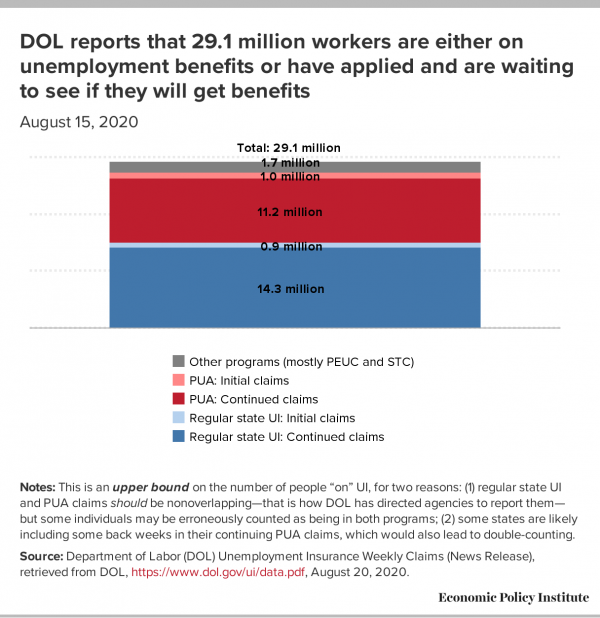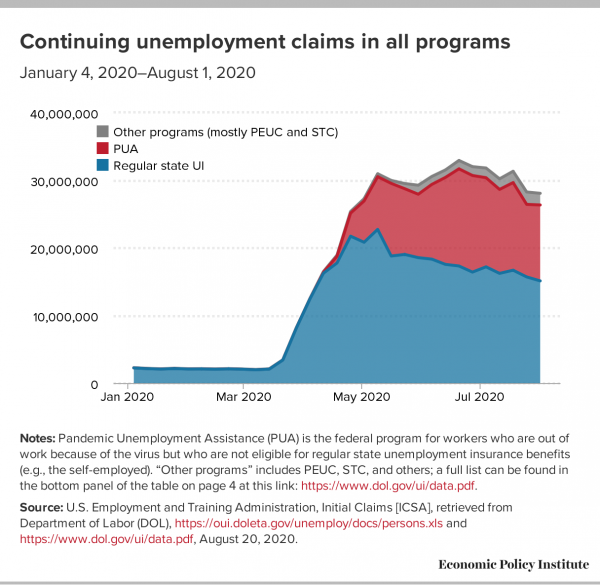https://www.epi.org/blog/ui-claims-remain-historically-high-and-the-presidents-sham-executive-memorandum-is-doing-next-to-nothing-congress-must-reinstate-the-600/
Last week 1.4 million workers applied for unemployment insurance (UI) benefits. Breaking that down: 892,000 applied for regular state unemployment insurance (not seasonally adjusted), and 543,000 applied for Pandemic Unemployment Assistance (PUA). Some headlines this morning are saying there were 1.1 million UI claims last week, but that's not the right number to use. For one thing, it ignores PUA, the federal program that is serving millions of workers who are not eligible for regular UI, like the self-employed. It also uses seasonally adjusted data, which is distorted right now because of the way Department of Labor (DOL) does seasonal adjustments.
Republicans in the Senate allowed the across-the-board $600 increase in weekly UI benefits to expire. Last week was the third week of unemployment in this pandemic for which recipients did not get the extra $600. That means people on UI are now are forced to get by on the meager benefits which are in place without the extra payment, which are typically around 40% of their pre-virus earnings. It goes without saying that most folks can't exist on 40% of prior earnings without experiencing a sharp drop in living standards and enormous pain.
Earlier this month, President Trump issued a sham of an executive memorandum. It was purported to give recipients an additional $300 in benefits. But in reality, even this drastically reduced benefit is only available to recipients in a handful of small states, and only for a few weeks. The executive memorandum is a false promise that actually does more harm than good because it diverts attention from the desperate need for the real relief that can only come through legislation.
This is cruel, and terrible economics. The extra $600 was supporting a huge amount of spending by people who now have to make drastic cuts. The spending made possible by the $600 was supporting 5.1 million jobs. Cutting that $600 means cutting those jobs—it means the workers who were providing the goods and services that UI recipients were spending that $600 on lose their jobs. The map in Figure B of this blog post shows many jobs will be lost by state now that the $600 unemployment benefit has been allowed to expire. We remain 12.9 million jobs below where we were before the virus hit, and the unemployment rate is higher than it ever was during the Great Recession. Now isn't the time to cut benefits that support jobs.
Last week was the 22nd week in a row that initial unemployment claims were far greater than the worst week of the Great Recession. If you restrict this comparison just to regular state claims—because we didn't have PUA in the Great Recession—last week was the 22nd week in a row that initial claims have been greater than the second-worst week of the Great Recession. Initial claims rose last week, but ticked down in the prior two weeks. Some are wondering if that decline was a result of the $600 running out. The answer to that is an emphatic no. Though initial claims remain at extremely high levels, they have been fairly steadily dropping since their peak in early April, and what has happened since the $600 expired is just a continuation of those trends.
In other words, the $600 was not the reason people were applying for unemployment insurance—it is not what was keeping people out of work. In fact, rigorous empirical studies show that any theoretical work disincentive effect of the $600 was so minor that it could not even be detected. For example, a study by Yale economists found no evidence that recipients of more generous benefits were less likely to return to work, which is what we would expect to see if the extra payments really were a disincentive to work. And a case in point: in May/June/July—with the $600 in place—9.3 million people went back to work, and a large share of likely UI recipients who returned to work were making more on UI than their prior wage, but that did not stop them from going back. Further, there are 11.2 million moreunemployed workers than job openings, meaning millions will remain jobless no matter what they do. Slashing the $600 cannot incentivize people to get jobs that are not there. Even further, many people are simply unable to take a job right now because it's not safe for them or their family, or because they have care responsibilities as a result of the virus. Slashing the $600 cannot incentivize them to get jobs, it is just causing hardship.
Slashing the $600 is also exacerbating racial inequality. Due to the impact of historic and current systemic racism, Black and brown communities are suffering more from this pandemic, and have less wealth to fall back on. They are taking a much bigger hit with the expiration of the $600. This is particularly true for Black and brown women and their families, because in this recession, these women have seen the largest job losses of all.
Figure A combines the most recent data on both continuing claims and initial claims to get a measure of the total number of people "on" unemployment benefits as of August 15. DOL numbers indicate that right now, 29.1 million workers are either on unemployment benefits, have been approved and are waiting for benefits, or have applied recently and are waiting to get approved. But importantly, Figure A provides an upper bound on the number of people "on" UI, for two reasons: (1) Some individuals may be being counted twice. Regular state UI and PUA claims should be non-overlapping—that is how DOL has directed state agencies to report them— but some individuals may be erroneously counted as being in both programs; (2) Some states are likely including some back weeks in their continuing PUA claims, which would also lead to double counting (the discussion around Figure 3 in this paper covers this issue well).

Figure B shows continuing claims in all programs over time (the latest data are for August 1). Continuing claims are more than 26 million above where they were a year ago. However, the above caveat about potential double counting applies here too, which means the trends over time should be interpreted with caution.

-- via my feedly newsfeed

No comments:
Post a Comment